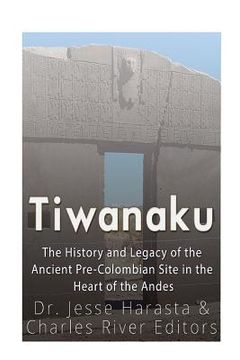Tiwanaku: The History and Legacy of the Ancient Pre-Colombian Site in the Heart of the Andes (en Inglés)
Reseña del libro "Tiwanaku: The History and Legacy of the Ancient Pre-Colombian Site in the Heart of the Andes (en Inglés)"
*Includes pictures *Includes historical accounts describing the site *Includes online resources and a bibliography for further reading "Tiahuanaco is not a very large village, but it is celebrated for the great edifices near it, which are certainly things worth seeing. Near the buildings there is a hill made by the hands of men, on great foundations of stone. Beyond this hill there are two stone idols, of the human shape and figure, the features very skillfully carved, so that they appear to have been done by the hand of some great master. They are so large that they seem like small giants, and it is clear that they have on a sort of clothing different from those now worn by the natives of these parts." - Cieza de Léon, 1883 Few ancient ruins capture the imagination like the mighty holy site of Tiwanaku, located on the high Andean altiplano plateau outside of La Paz, Bolivia. Unlike some ancient sites, such as Machu Picchu in neighboring Peru or Chichen Itzá in Mexico, Tiwanaku has never been "lost"; on the contrary, it has been marveled over for centuries by Incan nobles, Spanish Conquistadores, modern backpackers, and UFO fanatics alike. Despite this history of amazement, Tiwanaku has remained something of an enigma until recently, but it appears that this would have probably been pleasing to its creators. It was created to be a mysterious, sacred, and beautiful place, one with many secrets and a public face characterized by PT Barnum-like showmanship. Skillful modern archaeology has allowed people to look behind the facade and see, for the first time in many, many centuries, some of the secrets behind it. The story is fascinating, complex, and thoroughly human. The modern visitor arriving to Tiahuanaco finds him or herself in, as Cieza de Léon noted almost 130 years ago, a not very notable, dusty, chilly settlement south of Lake Titicaca. The place would not be of any great interest except that to the east and south of the modern village, within walking distance of the center, rise a number of remarkable ruins. The eastern complex is the larger of the two and encompasses the ceremonial heart of the ancient settlement, including the massive Akapana Pyramid, the Kalasaya Temple, and the famed Puerta del Sol (Gate of the Sun). Visitors typically pose before this remarkable gateway, carved out of a single 10-ton block of andesite and decorated with elaborate carvings, including a curious figure in the center of a man bearing two rods or staffs in its hands. Visitors leaving this central complex travel south - perhaps stopping at the Ceramic Museum, containing typical works of red and white geometric and zoomorphic images on red earthenware - to the southern complex, centered on the famed ruins of Puma Punku. While this typically makes up the entirety of a visitor's time in the ruins, what is often overlooked is that these ceremonial buildings were surrounded by a vast array of lesser structures, many of which appear to have been cannibalized for their stone to build the modern town, especially the church of San Pedro in the main square (Bolivia es Turismo 2016). Beyond this was an impressive system of aqueducts and irrigation, broad expanses of carefully controlled fields, outlying settlements, and a vast network of dependent, conquered territories. Together they make up the political, spiritual, economic, and artistic world which today is called "Tiwanaku," a place, empire, and cultural tradition that is the focus of this text. Tiwanaku: The History and Legacy of the Ancient Pre-Colombian Site in the Heart of the Andes chronicles the history and archaeology of the famous site. Along with pictures depicting important people, places, and events, you will learn about Tiwanaku like never before.

